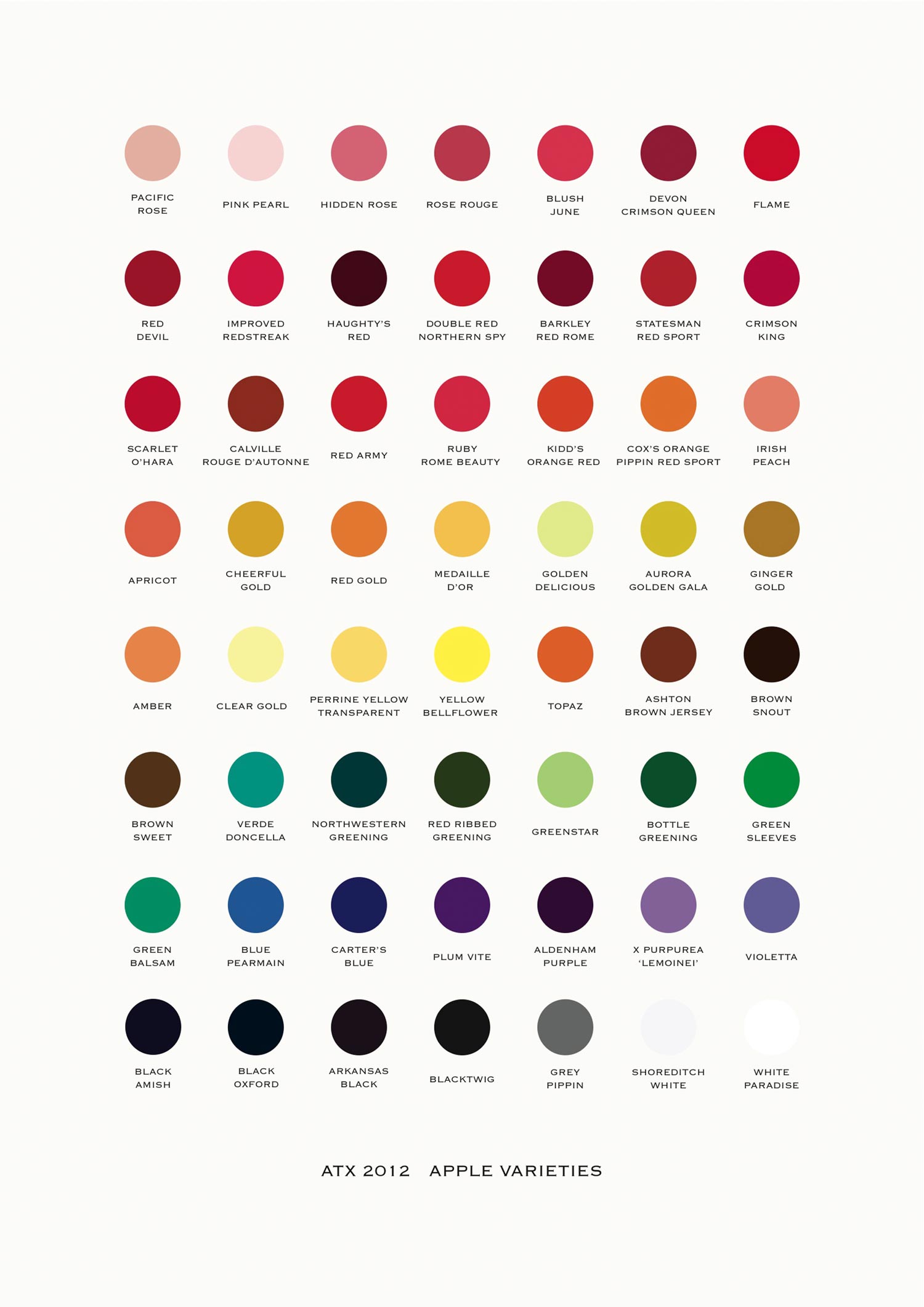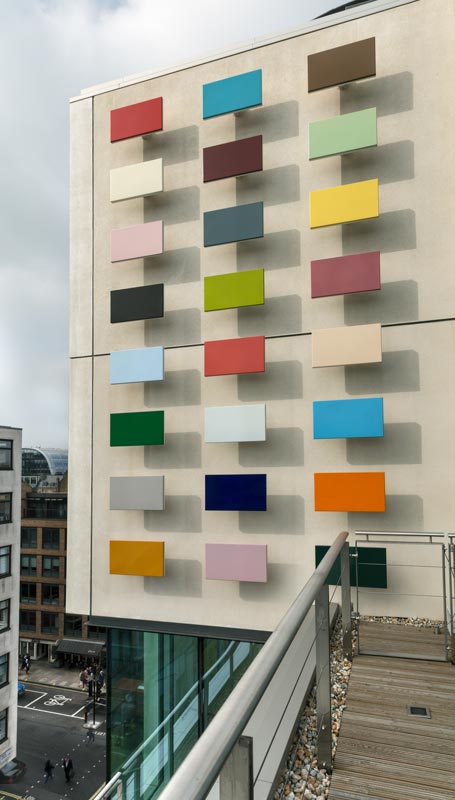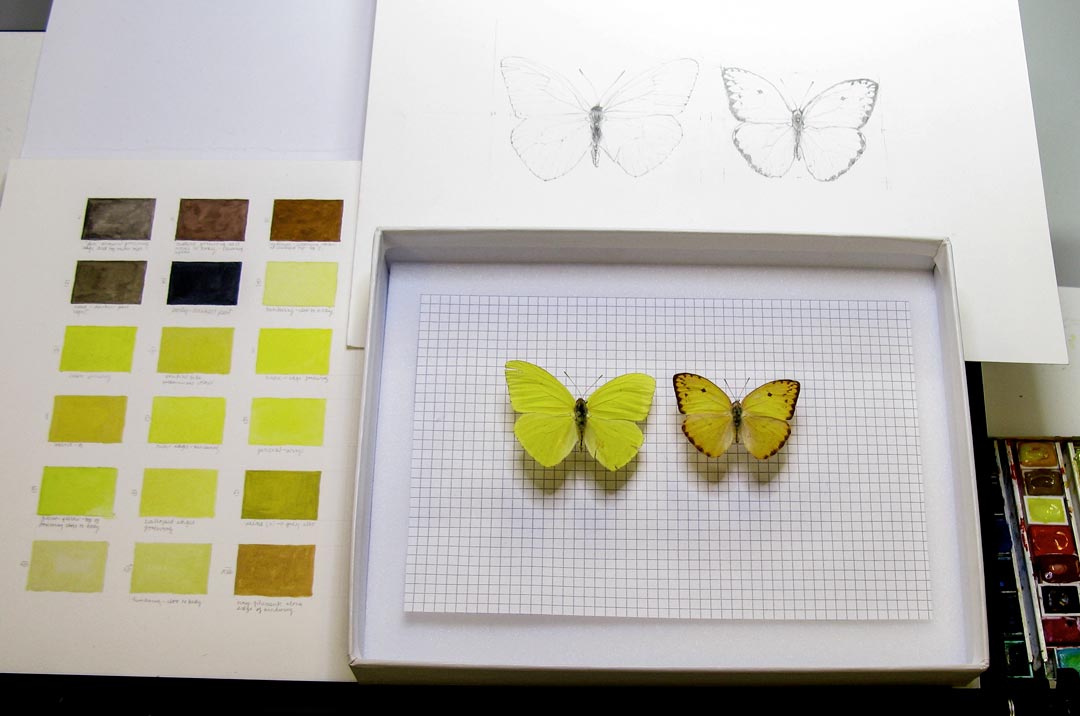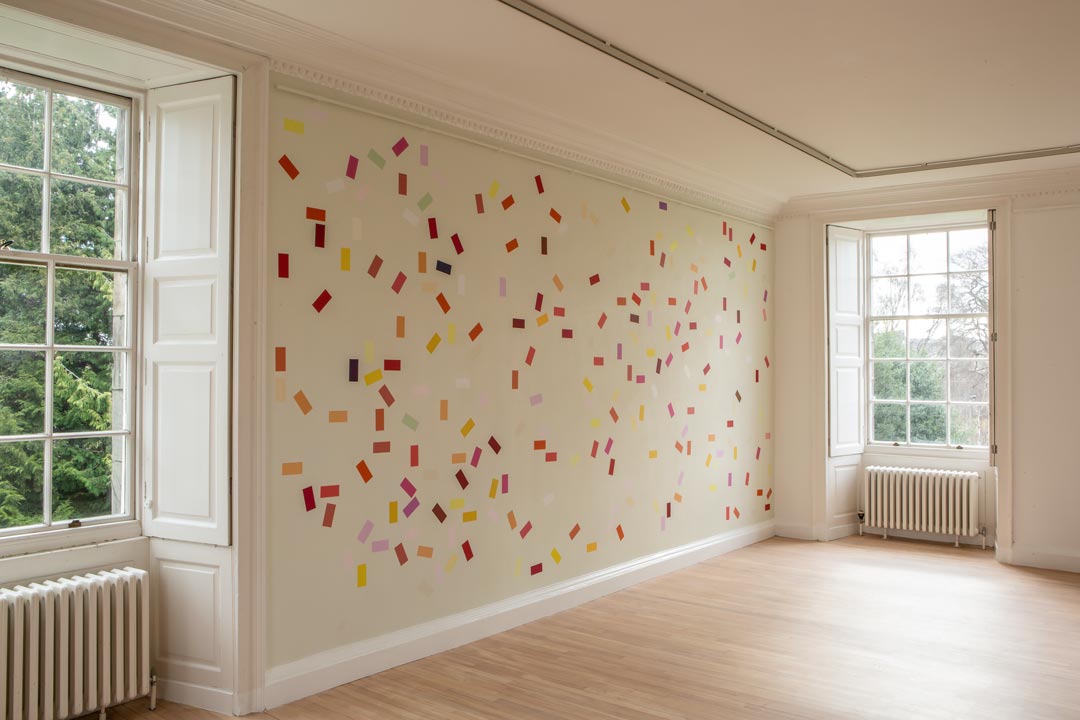ATX 2012 Apple Varieties
Alison Turnbull
Artist Alison Turnbull, who lives and works in London, transforms readymade information – plans, diagrams, blueprints, charts – into abstract paintings and works on paper. The found source material is reimagined and made vivid through colour and the working process. She also makes editioned prints and has undertaken architectural commissions.
ATX 2012 Apple Varieties was created in 2012 for the exhibition ‘With an Apple I will Astonish’ at the Large Glass gallery in London, which asked artists and thinkers to consider the apple, its narratives, meanings and beauties across drawing, painting, object and sound. Despite not having worked with apples before, Alison Turnbull was invited to participate because of her artistic approach to structure and indexation, and the use of colour.
Alison had been working with ideas of colour, particularly the transition from analogue descriptions of colour to digital code. She used the paint colour chart as her starting point, carefully selecting colours to pair up with names of 56 different apple varieties. The colours were created by digitally mixing cyan, magenta, yellow and black. The process of selecting the names was iterative, Alison searching the web and books for apple variety names that have colour words in them.
“I thought that names would be a good place to start – I was amazed that there’s a Blue Pearmain, a Greenstar, a Topaz, and even an Arkansas Black. There are wonderfully evocative names for apple varieties…”
The sequence ends with ‘White Paradise’. This is also the actual colour of the paper upon which the colour chart was printed, the off-white background being a printed colour. A limited edition of 50 prints measuring 42 x 29.7 cm was produced.
“I loved the idea that there was an apple called White Paradise and I thought I would end with that one….It’s something that you don’t need to know when you look at the print but to me it was important that one of the apple variety colours is actually the paper material itself.”
Unknown to Alison at the time, ‘Paradise apple’ was also the name given to trees grown for rootstocks onto which apple varieties are grafted. A fitting coincidence.
Alison is interested in human classification of the natural world, including botanical taxonomies such as the collection of butterflies and moths.
ATX 2012 Apple Varieties is a systematic representation of the apple world through language brought to life through colour. Its power is that in using this lens, she approaches the consideration of the richness of the apple population in a novel way.
“My interest is in colour rather than apples per se but I wanted to suggest that in an apple there could be the whole world of colour, and obviously I was helped hugely by the names.”
Comparing her digital colour chart to a circular colour wheel that organises the hues of colour in relation to the primary colours, she explains:
“I guess one could say that the circular colour wheel is an analogue way of representing colour and the colour chart (usually comprised of rectangles) is its digital manifestation. One of the earliest colour wheels, created by Moses Harris in the eighteenth century, is said to have been made so that he could more accurately mix the colours of the wings of the moths and butterflies he collected and painted. So the analogue is perhaps about mixing and the digital about separating.”
The name ATX 2012 simply means ‘Alison Turnbull created October 2012’ so the title ATX 2012 Apple Varieties is itself a combination of digital and analogue and a reference to the apple month. The work explores the language of the apple, the rich poetry of their names. The colours are designed to evoke the apple names, not a literal reflection of the skin tones of the actual apple. Generally, however, names of apple that incorporate a colour will reference either the apple’s skin or flesh so there will be some similarity. Although Alison wanted it to look like a standard colour chart, rather than the usual rectangles the colour chart is a grid of circles to reference the shape of an apple.
Alison was born in Bogotá, Colombia and lived in various countries around the world before settling in north London. Although this print is the only artwork that Alison has produced featuring apples, the fruit is significant to her. She recalls that apples were a rare treat when she was growing up in Latin America and being very excited at the age of eight or nine to have a Granny Smith apple – which seemed positively exotic – in a packed lunch whilst staying with her maternal grandmother in England.
Afterword
Description of the apple varieties that Alison selected for their names
| Apple Varieties | Origin | Description |
| Pacific Rose | New Zealand | Sweet late-season dessert apple. Trade name of Scirose, bred from Gala and Splendour in 1984 |
| Pink Pearl | California USA | Pink fleshed eating apple developed by Albert Etter in 1944 |
| Hidden Rose | Oregon USA | Pink fleshed chance seedling found in the Newell’s orchard in the early 1960s |
| Rose Rouge | France | Dessert apple, green with bright red blush on sun exposed skin and a slight russet around the stem |
| Blush June | North Carolina USA | Also known as Carolina Red June, early ripening white flesh with red stain recorded 1848 |
| Devon Crimson Queen | Cornwall UK | Dessert apple with crimson stained flesh close to the skin, also called Queenie |
| Flame | Essex UK | Raised by W Seabrook & Sons in 1925, a cross of Rival and Worcester Pearmain. Pink with red flush |
| Red Devil | Kent UK | Late season dessert apple with yellow skin and red flush bred by Hugh Ermen in 1975 from Discovery and Kent |
| Improved Redstreak | Herefordshire UK | Possibly a version of a bittersweet cider apple grown in the seventeenth century. Golden yellow with mahogany stripes |
| Haughty’s Red | Worcestershire UK | Yellow/green sweet dessert apple with red striping |
| Double Red Northern Spy | New York USA | Deep red skinned sport of Northern Spy found by William Green in 1895 |
| Barkley Red Rome | Washington USA | A darker red mutation of the Rome Beauty culinary apple found G L Barkley in 1944 |
| Statesman Red Sport | New Zealand | Sport of Australian Stateman dessert apple found in 1914 |
| Crimson King | Devon UK | Deep red culinary and cider apple raised by John Toucher in the nineteenth century |
| Scarlet O’Hara | New Jersey/Illinois | Yellow skinned eating apple with brown/red wash, developed as Co-op 25 from an extensive programme by Purdue, Rutgers and Illinois Universities and released 1984 |
| Calville Rouge D’Autonne | France | Large crimson cooking and dessert apple dating from 1670 [properly Calville Rouge D’Automne] |
| Red Army | Oxfordshire UK | Crisp eating apple with yellow/bright red skin. A cross of Chatley’s Kernal and Worcester Pearmain bred by FW Wastie in 1924. |
| Ruby Rome Beauty | Oregon USA | Culinary apple that is another highly coloured clone of Rome Beauty, found by M F Hubbs and introduced in 1928 |
| Kidd’s Orange Red | New Zealand | Bred by John Kidd in 1924, a cross of Cox’s Orange Pippin and Delicious. Mother of Gala. |
| Cox’s Orange Pippin Red Sport | Kent UK | A redder skinned mutation of the popular eating apple that was extensively planted in the UK |
| Irish Peach | Ireland | Found in 1819, an eating apple with good flavour with yellow/green/orange skin. A favourite in Victorian and Edwardian England |
| Apricot | Oregon USA | Culinary apple found as a roadside seedling in the 1980s, having pale orange flesh |
| Cheerful Gold | Kent UK | Crisp eating apple bred by Nuvar as variety NC1 in 1979 by crossing Cox’s Orange Pippin and Golden Delicious |
| Red Gold | Washington, USA | Bred by F.A. Schell in 1946, a cross of Red and Golden Delicious. Claims to be the sweetest apple on the market. |
| Medaille D’Or | Rouen, France | Russet high tannin cider apple seedling raised by M.Godard in 1865 and introduced to the UK in 1884 |
| Golden Delicious | West Virginia, USA | Found by J M Mullins in 1891 and acquired by Stark Brothers in 1914. Because of its juicy crispness and storability is frequently used for breeding |
| Aurora Golden Gala | Canada | Yellow skimmed, cream fleshed eating apple bred at Summerland Research Station in 1981, a cross between Splendour and Gala |
| Ginger Gold | Virginia, USA | Found by Clyde and Frances Ginger Harvey in 1969, an early season yellow eating apple which is a seedling of Golden Delicious |
| Amber | Essex, UK | Green and brown skinned dessert apple raised by W Seabrook & Sons before 1936 |
| Clear Gold | Pennsylvania, USA | Yellow sport of Golden Delicious |
| Perrine Yellow Transparent | Illinois, USA | A large tetraploid earlier-ripening sport of White Transparent, found by D.B.Perrine in 1930 |
| Yellow Bellflower | New Jersey, USA | Yellow seedling found in the nineteenth century that cooks to a golden puree |
| Topaz | Czech Republic | Cream fleshed, yellow and red skinned dessert apple bred by the Institute for Experimental Botany from Rubin and Vanda and introduced in 2001 |
| Ashton Brown Jersey | Bristol, UK | Purple-washed bittersweet cider apple bred at Long Ashton Research Station in 1903 |
| Brown Snout | Herefordshire, UK | Heavy russet late flowering cider apple, a chance seedling found in 1850 on Mr Dent’s farm |
| Brown Sweet | Yellow/green skin with red cheeks and russeting and juicy sweet flesh. | |
| Verde Doncella | Spain | Pale yellow and orange skin with hard white flesh, a dual purpose apple dating from the nineteenth century |
| Northwestern Greening | Wisconsin, USA | Pale green culinary apple, a seedling raised by Jasen Hatch in 1849 |
| Red Ribbed Greening | Devon, UK | Also called Cornish Pine, a seedling of Cornish Gilliflower found pre 1920. Green skinned dessert apple with orange brown flushes and stripes |
| Greenstar | Belgium | The marketing name of the Nicogreen variety bred by Johan Nicolai in 1989 from Delcorf and Granny Smith. A green skinned eating apple |
| Bottle Greening | Vermont, USA | Multi-purpose apple with tender flesh and green skin blushed red, a chance seedling found in the early nineteenth century |
| Green Sleeves | Kent. UK | Green skinned dessert apple bred at East Malling Research in 1966, a cross of James Grieve and Golden Delicious |
| Green Balsam | Yorkshire, UK | Small green cooker referred to as the Farmer’s Wife |
| Blue Pearmain | Massachusetts, USA | Dual use apple with yellow/green skin with deep red striping and blue bloom |
| Carter’s Blue | Alabama, USA | A large sweet and tangy dessert apple with dull red stripes and blue bloom that was grown by Colonel Carter in 1840s |
| Plum Vite | Devon, UK | Early nineteenth century culinary apple, yellow skinned. Also known as Venus Pippin |
| Aldenham Purple | Hertfordshire, UK | Small red-fleshed Swedish descendant of Malus niedzwetzkyana |
| X Purpurea ‘Lemoinei’ | USA | Small deep purple apple, a descendent of Malus niedzwetzkyana |
| Violetta | Italy | Pale yellow skin with deep scarlet flush and cream coloured flesh. |
| Black Amish | Pennsylvania, USA | Late nineteenth century pale yellow eating apple with red stripes. |
| Black Oxford | Maine, USA | Dark red skinned dual purpose apple, with a black bloom. A seedling found on Mr Valentine’s farm in 1790 |
| Arkansas Black | Arkansas, USA | A seedling of Winesap with very dark purple skin, possibly found by John Crawford in the 1840s and mainly culinary use |
| Blacktwig | Tennessee, USA | A multi-purpose tart apple with yellow/green skin streaked with burgundy, found on Major Rankin Toole’s farm in 1830 |
| Grey Pippin | Essex. UK | A yellow/orange skin sweet apple found by John Tann in 1980 |
| Shoreditch White | Somerset, UK | A nineteenth century sweet and juicy dessert apple with orange skin |
| White Paradise | Scotland, UK | First documented in 1831, a culinary apple with green skin with red striping |










 The apple label art of Anne Rook
The apple label art of Anne Rook M.Legrand – Incubator and Creator of the Michelin
M.Legrand – Incubator and Creator of the Michelin